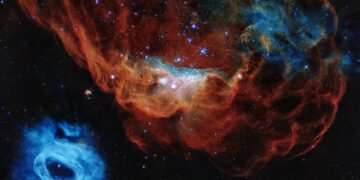The cosmos never ceases to amaze, and the latest image captured by the NASA/ESA Hubble Space Telescope is no exception. The “Tapestry of Blazing Starbirth” showcases the breathtaking nebulae NGC 2014 and NGC 2020, nestled in the Large Magellanic Cloud (LMC), about 163,000 light-years away. This portrait, a blend of artistry and science, provides not just a visual feast but also invaluable insights into the processes that shape our universe.
The Stellar Nurseries of NGC 2014 and NGC 2020
NGC 2014 and NGC 2020 are two neighboring nebulae in the LMC, a satellite galaxy of the Milky Way. Together, they form one of the most active star-forming regions observed by Hubble. NGC 2014, often referred to as the “Brain Nebula,” is dominated by bright, massive stars that energize surrounding hydrogen gas, causing it to glow in rich shades of red. In contrast, NGC 2020, a circular blue-hued structure, is sculpted by a single massive star shedding its outer layers in stellar winds.
The interplay between these regions highlights the diversity of star formation processes. While NGC 2014 exemplifies the chaotic energy of young, hot stars, NGC 2020 showcases the transformative power of stellar winds in shaping cosmic landscapes. Together, they offer a unique window into the intricate dance of creation and destruction that drives the universe.
Hubble’s Role in Capturing the Cosmic Canvas
Hubble’s unparalleled ability to capture high-resolution images has made it an indispensable tool for astronomers. The telescope’s Wide Field Camera 3 (WFC3) was instrumental in creating this vivid image. By observing in multiple wavelengths of light, Hubble revealed the contrasting colors and structures of the nebulae, translating scientific data into an awe-inspiring visual narrative.
The choice of the Large Magellanic Cloud as the observation site is strategic. Its relative proximity allows astronomers to study star-forming regions in unprecedented detail, bridging the gap between our galaxy and the broader cosmos.
The Science Behind the Beauty
At the heart of NGC 2014 and NGC 2020 are massive stars whose intense radiation and stellar winds shape their surroundings. These stars, burning at millions of degrees, release vast amounts of energy that ionize surrounding hydrogen gas. This ionization process is responsible for the nebulae’s vivid colors: red from hydrogen gas and blue from oxygen-rich regions.
These regions are also hotspots for stellar feedback—a phenomenon where massive stars influence the formation of subsequent generations of stars. The winds and radiation from these stars compress nearby gas clouds, triggering the collapse of new stars while simultaneously dispersing material that might otherwise have formed stars. This dual role underscores the dynamic and cyclical nature of star formation.
Hubble’s Legacy and the Road Ahead
Hubble has been a cornerstone of modern astronomy for over three decades, and images like the “Tapestry of Blazing Starbirth” reaffirm its enduring relevance. However, the telescope’s capabilities are not just about capturing stunning visuals. They lie in its ability to provide multi-wavelength data, which allows scientists to dissect the physical and chemical processes at play in distant regions.
As Hubble continues its mission, it sets the stage for its successor, the James Webb Space Telescope (JWST). With its advanced infrared capabilities, JWST promises to peer even deeper into the cosmos, uncovering regions obscured by dust and revealing the birthplaces of stars with unparalleled clarity. Together, these telescopes are poised to revolutionize our understanding of the universe.
Implications for Astronomy and Humanity
The “Tapestry of Blazing Starbirth” is more than a scientific achievement; it is a reminder of humanity’s insatiable curiosity and ingenuity. It underscores the importance of continued investment in space exploration and research, not just for advancing science but also for inspiring future generations.
Studying star-forming regions has practical implications as well. Understanding the processes that govern star formation can inform the search for habitable planets and the origins of life. Moreover, it enhances our understanding of the cosmic forces that have shaped our own solar system, providing context for our place in the universe.
Conclusion: A Celebration of Cosmic Wonder
The image of NGC 2014 and NGC 2020 is a testament to the power of human imagination and technology. It invites us to marvel at the beauty of the universe while reflecting on the profound processes that sustain it. As we stand on the brink of new discoveries with telescopes like JWST, let this “Tapestry of Blazing Starbirth” serve as a reminder of the infinite wonders awaiting our exploration.



















